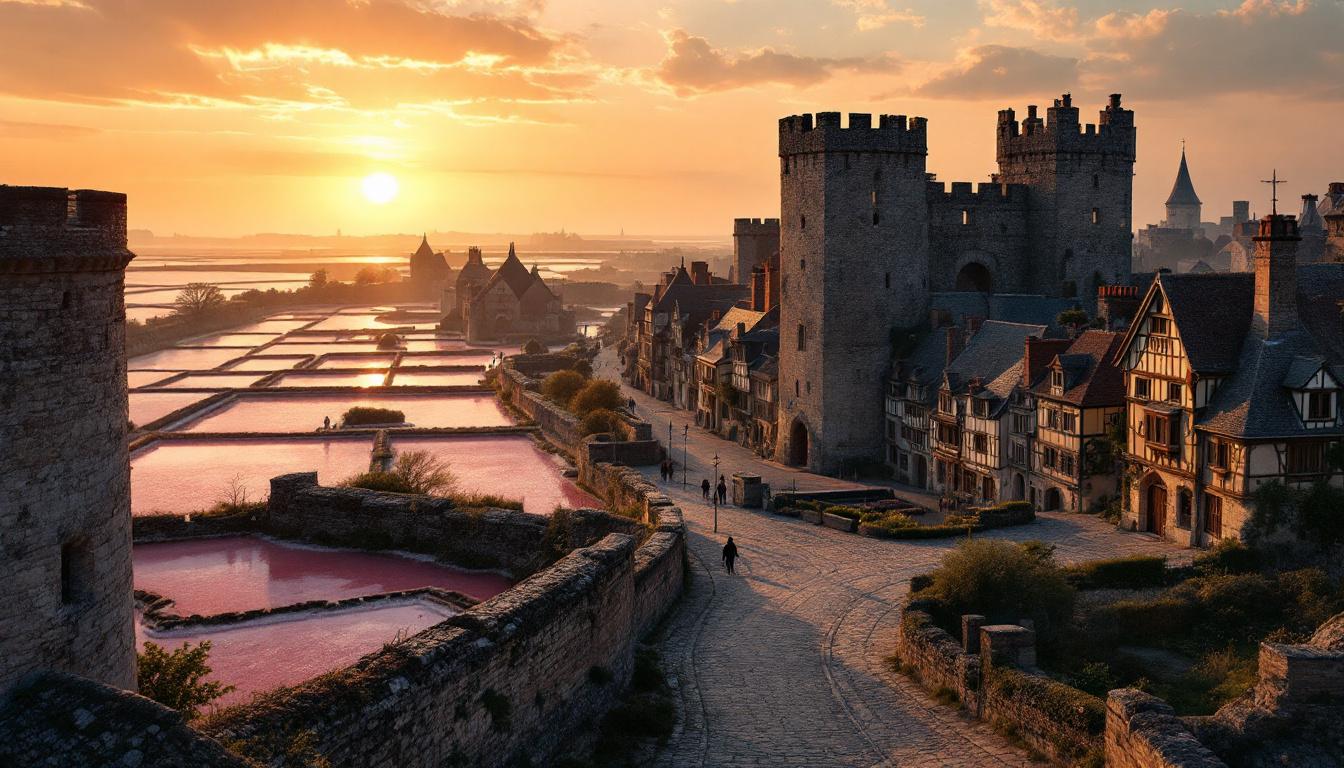Most travelers to France’s Atlantic coast gravitate toward glitzy resort towns, completely missing the medieval masterpiece of Guérande. This remarkably preserved walled city produces some of the world’s finest salt and offers an authentic glimpse into French heritage that’s remarkably unspoiled by mass tourism.
A medieval fortress hiding culinary treasure
Guérande’s impressive 4,600-foot medieval ramparts encircle a town that looks like it was frozen in the 15th century. The imposing Porte Saint-Michel gate stands as the grand entrance to this stone-walled time capsule, where cobblestone streets wind between half-timbered houses and artisan workshops.
“Our walls have protected not just our city but our way of life,” explains Marie Lefort, a ninth-generation salt harvester. “While other coastal towns transformed for tourism, Guérande maintained its soul.”
The “white gold” that shaped a civilization
The town’s identity revolves around its famous salt marshes, which have been harvested by hand since the 9th century. These 5,000 acres of shallow pools produce the prized Fleur de Sel de Guérande—delicate salt crystals hand-collected from the water’s surface using wooden tools that haven’t changed in centuries.
Watching paludiers (salt workers) rake crystallizing salt at dawn offers a meditative glimpse into an ancient profession. The geometric patchwork of salt pans stretches toward the horizon, shifting from silver to pink as the light changes throughout the day.
A taste of culinary heritage
Guérande’s salt has shaped regional cuisine in ways that extend far beyond seasoning. The town’s signature treat is kouign-amann, a butter-rich pastry with caramelized layers often sprinkled with local salt. For the ultimate taste experience, try salted caramel from Maison des Paludiers, where butter and sugar transform into gold when kissed by Guérande’s crystals.
At local bistros, order traditionally preserved fish or vegetables that showcase salt’s preservative powers. These foods connect directly to medieval preservation techniques that made Guérande wealthy centuries ago.
Secret spots most visitors miss
While tourists flock to the impressive Collegiate Church of Saint-Aubin, locals recommend exploring the quieter Notre-Dame la Blanche church, with its remarkable acoustics that amplify even whispered prayers. Early mornings along the eastern ramparts offer uninterrupted views of mist rising from the salt marshes—a photographer’s dream that most visitors never witness.
Like Provence’s hidden fountain villages, Guérande rewards those who explore beyond the obvious attractions.
Beyond salt: unexpected discoveries
The Musée des Marais Salants near Batz-sur-Mer illuminates the region’s salt-harvesting history, but adventurous visitors should explore the nearby Parc Naturel Régional de Brière. This protected wetland offers boat tours through channels where traditional thatched cottages emerge from mist-shrouded marshes.
“The relationship between our marshes, the Atlantic, and our medieval town creates a harmony you won’t find elsewhere in France,” notes historian Jean Bouvier. “It’s a delicate balance preserved for over a thousand years.”
Unlike Spain’s medieval cities with their grand festivals, Guérande’s celebrations remain intimate affairs where visitors can join locals for June’s medieval festival, wearing period costumes while sampling ancient recipes.
For architecture enthusiasts, Guérande offers authentic medieval treasures without Barcelona’s crowds. Each stone tells stories of sailors, salt merchants, and defenders who shaped this strategic stronghold.
Like sacred islands balancing tradition with tourism, Guérande maintains its working heritage while welcoming visitors. The difference? Here, tourists number in thousands rather than millions, allowing genuine encounters with locals practicing centuries-old traditions.
While Paris dazzles with electric displays, Guérande offers simpler magic: sunlight crystallizing on salt ponds, medieval shadows stretching across ancient stones, and the taste of the Atlantic transformed into culinary gold by human hands that connect us directly to a thousand years of French heritage.
